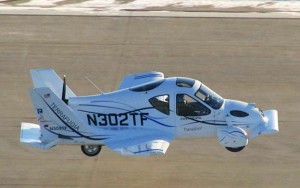
Come Josephine in my flying (and driving) machine, as the Terrafugia Transition comes closer to reality.
It’s been a fantasy for more than a century. Even Henry Ford hoped to find a way to get one of his early flivvers to fly, but after countless failures it may soon become a reality.
Federal regulators have approved a series of exemptions that could get the Terrafugia Transition off the drawing boards and into production as early as 2012.
Designers have equipped the car/plane hybrid with a variety of automotive safety features, including airbags, that typically aren’t offered by most private aircraft. The challenge has been to overcome some automotive standards that don’t quite work when your car is sprouting wings. So exemptions from certain rules, such as side-impact standards, had to be authorized by the National Highway Traffic Safety Administration.
That challenge resolved, Woburn, Massachusetts-based Terrafugia plans to have at least one production prototypes on display later this month at the EAA AirVenture, the annual “fly-in” at Oshkosh, Wisconsin that draws pilots and flying fans from around the world.
“The vehicle will not be ready to fly” at the show, as originally promised, noted a statement from the start-up aircraft maker’s CEO Carl Dietrich. “The first test flights would be expected in March of next year,” due to a number of other delays Terrafugia blames on its suppliers.
The Transition is designed to convert from car to aircraft in just 30 seconds. On the road it is rated to reach a top speed of 65 mph, with that climbing to 115 mph in the air. With its wings folded away the four-seater is small enough to fit in the typical American garage.
The maker expects to price the base version of the Terrafugia Transition at around $200,000, with a more lavishly equipped version nudging closer to $300,000.
The company claims it has the financial wherewithal to last until it gets its critical airworthiness certificate, having recently raised nearly $1 million in private equity funding.
There are still plenty of challenges ahead, as the latest delay underscores, Terrafugia initially planning to have the prototype Transition demonstrating its abilities, rather than just sitting on the tarmac, at this year’s AirVenture.
“The delay resulted from a combination of production design challenges and problems with third party suppliers. The company has declined to go into more detail, but maintains its continued commitment to the success of the Transition program,” said a statement from Terrafugia.
This isn’t the first time a flying car has come close to making the transition from sci-fi to reality. Henry Ford had several prototypes running but cancelled the project when a close friend and test pilot was killed in a crash.
Other flying car programs have actually gotten into the air but failed to make the transition to commercial reality.
Few expect to see a vehicle like the Transition live up to the Jetsons reality of putting everyday commuters into the air. But the hope is that there’s enough of a market to support a low-volume maker like Terrafugia – on the consumer side.
The military is also getting serious about flying cars that could permit a small squad of soldiers to leapfrog from battle to battle without being exposed to such things as the homemade explosives, or IEDs, that have killed or wounded thousands of U.S. troops in Iraq and Afghanistan.
As TheDetroitBureau.com previously reported, the Pentagon’s research arm, DARPA, has set a goal of developing a vehicle that can haul up to 1,000 pounds of soldiers and their gear for up to 250 miles on land and in the air.
There are now six finalists for the Transformer (TX) program, with a goal of having a working prototype ready within the next year.
(Click Here for more on the AVX Transformer, one of the designs competing in the DARPA program.)
